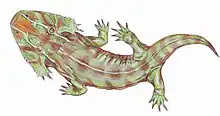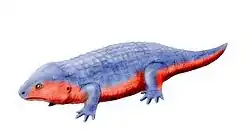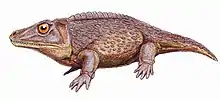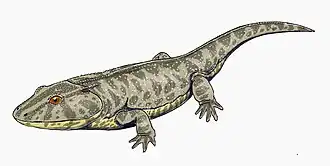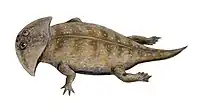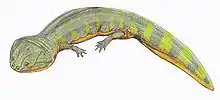| Eryopoidea | |
|---|---|
 | |
| Life restoration of Eryops megacephalus | |
| Scientific classification | |
| Domain: | Eukaryota |
| Kingdom: | Animalia |
| Phylum: | Chordata |
| Class: | Amphibia |
| Order: | †Temnospondyli |
| Suborder: | †Euskelia |
| Superfamily: | †Eryopoidea Cope, 1882 |
| Families | |
Eryopoidea is a clade of late Carboniferous and Permian temnospondyl amphibians, known from North America and Europe. Carroll (1998) includes no fewer than ten families,[1] but Yates and Warren (2000) replaced this with a cladistic approach that includes three closely-related families, the Eryopidae, Parioxyidae and Zatrachydidae.[2] They define the Eryopoidea as all members of Euskelia in which the choana are relatively rounded and the iliac blade is vertical. A similar definition (without specifically naming Euskelia) is provided by Laurin and Steyer (2000).[3]
References
- ↑ Carroll, R. L. (1988). Vertebrate Paleontology and Evolution. W.H. Freeman & Co. ISBN 0-7167-1822-7.
- ↑ Yates, A. M. & Warren, A. A. (2000). "The phylogeny of the 'higher' temnospondyls (Vertebrata: Choanata) and its implications for the monophyly and origins of the Stereospondyli". Zoological Journal of the Linnean Society. 128 (1): 77–121. doi:10.1111/j.1096-3642.2000.tb00650.x.
- ↑ Laurin. M & Steyer, J-S (2000). "Phylogeny and Apomorphies of Temnospondyls - Tree of Life project".
External links
- Palaeos
- Eryopoidea – Mikko's Phylogeny Archive
This article is issued from Wikipedia. The text is licensed under Creative Commons - Attribution - Sharealike. Additional terms may apply for the media files.


